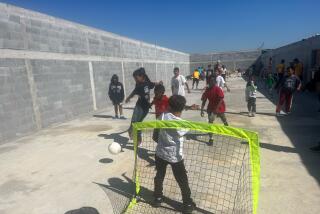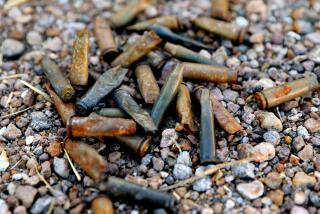Its Poverty Is a Political Goad : Northeast Brazil: Study in Contrast
- Share via
SALVADOR, Brazil — Two girls, each clutching a fistful of purple ribbons, darted through the waterfront crowd celebrating the annual Festival of Our Lady of the Beach, the patroness of sailors and fishermen.
“Buy a ribbon. It will bring you luck,” one of the girls said.
She was not yet an adolescent, despite the rouge on her brown cheekbones. In a wink, she had tied a ribbon on the wrist of a man drinking beer. His small payment went into the waistband of her shorts, and she was gone.
“I know them,” the man said. “They are child prostitutes.”
The man was Joao Amado, who works for a city agency that is trying to preserve historical sites in this port city that was once Brazil’s colonial capital and is still the center of Afro-Brazilian culture.
Amado said the girls lived in Pelourinho, a slum neighborhood beside the churches and convents of the old historical center, where old houses that should be salvaged have been turned into tenements. Prostitution and drug-dealing flourish in dark hallways; the police enforce an undeclared curfew at night to fight crime.
The people who live there, even those who work on the docks, in the marketplaces, or as self-employed peddlers and artisans, stay on because there is no other affordable housing available. At least half the city’s 2 million people live in the slums.
Salvador, the capital of the state of Bahia, is one of three cities--the others are Recife and Fortaleza--in the nine-state region known as the Northeast that has more than a million people. All three show the same contrasts of wealthy residential sections, with modern speedways for auto traffic, and mushrooming slum areas crossed by muddy streets and public housing projects.
The big cities of central and southern Brazil, including Sao Paulo, Rio de Janeiro and Belo Horizonte, also are infested with large slums and serious urban problems, but living conditions there do not reach the level that makes Brazil’s Northeast the largest center of poverty in Latin America.
The contrast between the relative affluence of the central southern region and the poverty of the Northeast is a political goad for the national conscience.
Afflicted by Droughts
At least 35 million people live in the Northeast, a mainly agricultural region that is afflicted by severe cyclical droughts. The region has nearly 30% of Brazil’s population, but its per capita income, estimated at $850 a year by the federal Agency for Development in the Northeast, compares with a national average of about $1,700 a year and about $3,500 in the metropolitan area of Sao Paulo, Brazil’s largest city and industrial center.
The roots of the Northeast problem lie not in the large cities, where modern industries have been attracted by tax incentives, but in the countryside. In the towns and rural areas of the vast interior, known as the sertao , there are 22 million people, 40% of whom own no land and survive either as laborers or sharecroppers.
The owners of big cotton farms, cattle ranches and sugar plantations pay wages that are so low that more than half of the region’s 12 million workers earn no more than the regional minimum salary, the equivalent of $40 a month.
Many on Government Relief
When drought strikes the interior, survival for many depends on government relief and work projects. The last drought, which began in 1980, ended only last year and at its peak the federal relief program had 2.8 million people at work building small dams, repairing roads and on other make-work projects in return for food packages and $20 a month.
The contrast between the Northeast and the central southern region has been a major political issue for 25 years, since the agency for Northeast development was established.
Its first director, economist Celso Furtado, said, “Either we empty the region of people, or we create an agrarian structure that will permit people to meet their basic needs in the region.”
But after a generation, and the exodus of 3.5 million people from the region to the south or to the new lands of western Brazil, the blight continues. The rich, particularly businessmen and landowners, have become much richer. The poor, particularly the landless peasants, have not shared at all in the economic growth, which averaged 7% a year in the 1970s.
With only 30% of the national population, the Northeast has more than half of the illiterates older than 10 and 63% of those whose nutrition level is below minimum standards. Infant mortality is 40% higher than in the south, and life expectancy is 10 years less.
President-elect Tancredo Neves has strong ties to the governors of the Northeast states; they helped elect him. He has said that the Northeast needs an emergency program to relieve hunger, particularly among children, and he has proposed an agrarian reform program that would distribute irrigated land to landless peasants.
But this would require substantial public investment, financed by the wealthier southern states, and a lessening in the long-standing resistance to land reform by the Northeast’s big plantation and ranch owners, who exercise powerful political influence in their states.
MP, Brazil, DON CLEMENT / Los Angeles Times
More to Read
Sign up for Essential California
The most important California stories and recommendations in your inbox every morning.
You may occasionally receive promotional content from the Los Angeles Times.













